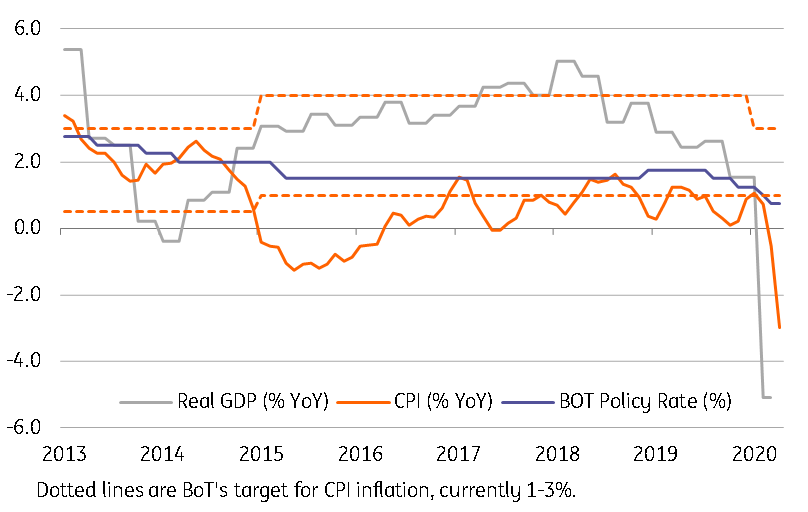Thailand: Steepest price fall since the financial crisis reflects huge drop in demand
We have slashed our full-year 2020 inflation forecast, to -2.3% from -0.8%, as the negative inflation trend in Thailand is likely to be entrenched. We are more confident than ever of our call for a 50 basis point Bank of Thailand rate cut at the next meeting on 20 May
| -3.0% |
April CPI inflation |
| Worse than expected | |
Steepest price fall since GFC
Thailand’s consumer price index (CPI) fell more than expected, by 3% year-on-year in April, much weaker than our -2% forecast and the -1.2% consensus median. This is the steepest CPI fall since the global financial crisis more than a decade ago. The negative inflation streak started in March with a 0.5% YoY fall. We believe it has further to run through the end of this year.
Core inflation remained in positive territory in April, although it dipped modestly to 0.4% from 0.5% in March, suggesting that a sharp slowdown in headline inflation largely came from food and fuel prices. Inflation in the food component slowed to 1% from 1.6%, led by a more than 4% plunge in fruit and vegetable prices. The housing component, where utility prices are also included, swung to -4.6% from +0.1%. And, transport worsened to -9.8% from -4.9%.
A sharp fall in inflation reflects significant demand destruction due to the Covid-19 pandemic. The disease has been under control and businesses are gradually reopening this week. Even though this should lessen the downside price pressure somewhat, we believe we are in for a long stretch of deflation ahead.
We now see a 3-4% CPI fall in the rest of the year, leading to a sharp downgrade to our annual inflation outlook for 2020 to -2.3% from -0.8%.
And, deepening output fall
Also released today, Thailand’s Markit manufacturing PMI plunged to 36.8 in April from 46.7 in March. This was the worst reading since the series began in 2016, led by a record decline in output, new orders, and employment components. The downward pressure on input prices continued to intensify, supporting our view of a sustained negative trend in consumer prices for the rest of the year. The business sentiment PMI component projecting 12 months ahead also pointed to continued deterioration.
All this points to a deepening manufacturing contraction and through that, GDP contraction in the current quarter. Released on 18 May, we estimate as much as a 5.1% YoY GDP fall in the first quarter of 2020. Our forecast for 2Q GDP growth is -8.3%.
Growth, inflation, and BoT policy

Call for a 50bp BoT rate cut in May
The latest activity data strengthens our confidence in our view that the Bank of Thailand should slash its policy rate further. The BoT cut the policy twice, by 25 basis points each, at meetings in February and March. Inflation has drifted well below the BoT’s medium-term policy target of 1-3%. With the policy rate at 0.75% currently this means a big spike in real interest rates – not a good thing for the economy suffering from its worst slump in more than two decades.
Latest activity data strengthens our confidence in our view that the Bank of Thailand should slash its policy rate further.
We believe another 50bp rate cut won’t hurt. And the earlier it’s implemented, the better it is for the post-Covid-19 economic recovery that’s still going to be long and drawn out due mainly to weak tourism and exports for a long time to come. This puts the focus on the upcoming BoT meeting on 20 May, by which time policymakers should have the first quarter GDP report to assess the policy. Undoubtedly, it’s going to be bad enough to validate a bigger, 50bp additional rate cut.
This publication has been prepared by ING solely for information purposes irrespective of a particular user's means, financial situation or investment objectives. The information does not constitute investment recommendation, and nor is it investment, legal or tax advice or an offer or solicitation to purchase or sell any financial instrument. Read more
Download
Download article
5 May 2020
Good MornING Asia - 6 May 2020 This bundle contains 4 Articles